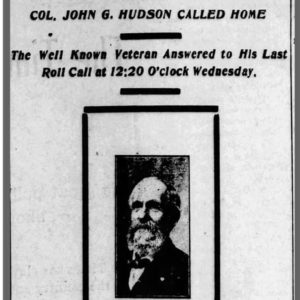calsfoundation@cals.org
John G. Hudson (1832–1908)
John G. Hudson was a Union officer during the Civil War who won distinction for his actions during the July 4, 1863, Battle of Helena and later was appointed as colonel of the Sixtieth U.S. Colored Infantry Regiment, which saw all of its service in Arkansas.
John Gardner Hudson was born on May 22, 1832, in East Palmyra, New York, the youngest of six sons of Samuel E. Hudson and Sally Hudson. Hudson attended Allegheny College in Meadville, Pennsylvania, and was a farmer and carpenter. He married Mary Sprague in 1854; the couple had a son and a daughter.
Hudson moved to Missouri and, at age thirty, mustered in as captain of Company B, Thirty-Third Missouri Infantry Regiment (US) on August 29, 1862. The Thirty-Third was transferred to Helena (Phillips County) on January 5, 1863, where the infantrymen were cross-trained to operate the artillery pieces at Fort Curtis and the four hill-top batteries that controlled the roads leading into town.
On July 4, 1863, Hudson was in command of the Union post at Battery D, the southernmost of the fortifications defending Helena, when Brigadier General James F. Fagan’s Confederates attacked. As the rebel assault faltered, Hudson called on Confederates huddled at the base of Battery D to surrender. When asked by what authority he asked for their surrender, Hudson replied: “By the authority of my twelve-pound howitzer.” The Confederates capitulated.
On July 7, 1863, the U.S. War Department authorized the state of Iowa to recruit a regiment of Black soldiers, and Hudson was selected to lead it. He was appointed as colonel of the First Iowa Infantry Regiment (African Descent) on September 21, 1863, though he did not formally muster out of the Thirty-Third Missouri until December 3, 1863.
Hudson apparently only took the field with the First Iowa (later designated the Sixtieth U.S. Colored Infantry) once, leading the regiment on the August 29–September 3, 1864, expedition up the White River from Helena, which included the Affair at Kendal’s Grist Mill. He served the remainder of the Civil War as colonel of the Sixtieth U.S. Colored Infantry, mustering out on October 15, 1865.
Hudson received a brevet promotion to brigadier general on October 9, 1867, to rank from March 13, 1865, for “distinguished gallantry at the battle of Helena, Ark., July 4, 1863.”
After the war, Hudson and his family moved to Tipton, Missouri, then relocated to Vernon County near Metz, Missouri, in 1868. In 1900, he moved to Metz, where he was active in the Methodist Episcopal Church, the Independent Order of Odd Fellows, and the Grand Army of the Republic. He was elected to the Metz town council and appointed town treasurer, and he served on the board of directors of the Metz Banking Company.
Hudson died on August 20, 1908, and is buried in Pryor Creek Cemetery in Metz.
For additional information:
Christ, Mark K. Civil War Arkansas, 1863: The Battle for a State. Norman: University of Oklahoma Press, 2010.
“Colonel John G. Hudson Called Home.” Metz [Missouri] Times, August 28, 1908, p. 1.
Dyer, Frederick. A Compendium of the War of the Rebellion. Des Moines, IA: Dyer Publishing Co., 1908.
Hunt, Roger D. Colonels in Blue—U.S. Colored Troops, U.S. Armed Forces, Staff Officers and Special Units: A Civil War Biographical Dictionary. Jefferson, NC: McFarland and Co., 2022.
Hunt, Roger D., and Jack R. Brown. Brevet Brigadier Generals in Blue. Gaithersburg, MD: Olde Soldiers Books, 1990.
“Requisat En Pace.” Metz Times, September 4, 1908, p. 1.
Mark K. Christ
Central Arkansas Library System
 Civil War through Reconstruction, 1861 through 1874
Civil War through Reconstruction, 1861 through 1874 Military
Military John G. Hudson
John G. Hudson  John G. Hudson Death Notice
John G. Hudson Death Notice 




Comments
No comments on this entry yet.